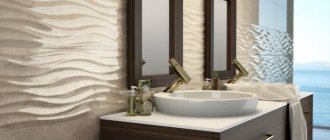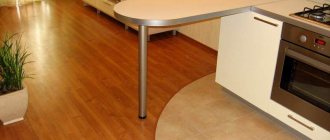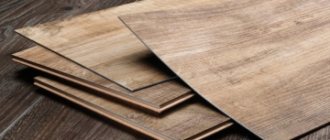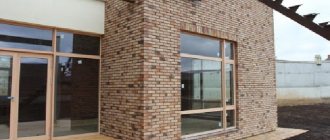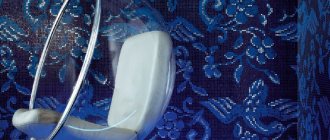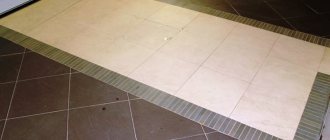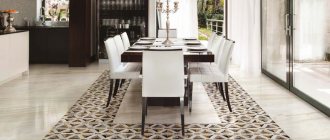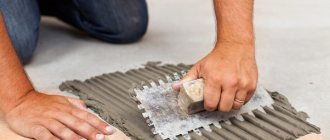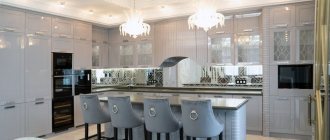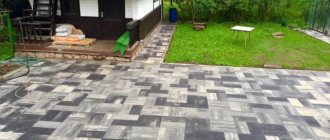Hexagon tiles attract attention with their unusual shape. It is most often used as floor tiles, but recently it can increasingly be seen as wall tiles. The original shape is a potential highlight for any interior style. Appearing on the market just a few years ago, honeycomb tiles quickly won the hearts of people, taking a strong position among many types of ceramic tiles.
- Hexagons in the world of tiles
- Peculiarities
- Hexagon Shape Meaning
- Types of hexagonal tiles
- Manufacturing method
- Surface treatment method
- Appearance
- Texture options
- Advantages and disadvantages
- Design
- Laying
- Manufacturers
- Hexagonal tiles in the interior
- For different rooms
- Buying tips
Hexagons in the world of tiles
Hexagon-shaped tiles can be found in many options. Manufacturers of porcelain stoneware provide a wide selection of different designs for this original form: from styling with traditional and natural materials, to exclusive design solutions. Honeycomb tiles can come in a variety of sizes - from large-format floor tiles to small mosaic elements. The hexagonal shape can have a wide variety of textures and surface types - just like any ordinary modern tile.
What it looks like
There is no point in understanding the nuances of masonry technology here - all work is carried out in exactly the same way as in the case of rectangular or square slabs, excluding the cutting technology, since these works will be complicated by the special shape of the trimmed parts. It is much more important to understand how the finished surface will look and decide whether such a design suits you. To do this, below are several photographs demonstrating the results of such repairs.
Peculiarities
The hexagon shape gives the tiles not only an unusual appearance, but also expands design possibilities. The combination of honeycombs of different colors and folding them into patterns looks much more impressive than in the case of ordinary wall or floor tiles. She has more possible styling schemes. The disadvantages include its higher cost and complexity of installation.
Hexagon Shape Meaning
Hexagonal ceramic tiles are by no means the first appearance of the hexagon in architecture and interior design. It’s not for nothing that they make hexagon tiles, and not octagons or pentagons. People have always drawn inspiration from nature. Bees with their honeycombs have been an important object in the culture of many peoples. Often this form symbolized protection from dark forces. This natural form can be found not only on Earth - most recently, a giant planetary vortex in the shape of a regular hexagon was noticed by scientists on Saturn. Knowing this, hexagonal tiles can be used not only as an unusual accent, but also give it a deep meaning.
How to seal the transition between floor coverings:
The nuances of joining without a threshold Basic design recommendations How to join seams Grout:
- Sealant
- Liquid plug
- Cork compensator
How to join sections without a seam When a threshold is needed Types of thresholds Video: how to join hexagon tiles
Two coatings are usually used for zoning rooms. For example, to visually separate the hallway from the corridor, or the living room from the kitchen, if they are combined. In this case, the transition line between materials can have a complex shape and a large length. It is advisable to design such a joint between tiles and laminate without a threshold.
It looks more attractive, dirt does not accumulate at the junction and no one will trip over it. But this technology is considered more complex than delimiting a room using a protrusion.
Types of hexagonal tiles
Hexagon tiles come in many different types. The following properties can be distinguished:
- Size. Most often, small sizes are found, such as 20x20 or 40x40 cm. 25x21 is a typical size for patterned European tiles. 28.5x32.5 – the size of a standard terracotta tile. There are larger options, as well as small hexagon mosaics.
- Color. The color palette is limitless. Most often you can see calm natural colors: beige, gray, brown.
- Proportions. In addition to regular hexagons, you can also find elongated options, for example, measuring 10x20 cm.
- Surface. Glossy, matte, lapped (semi-matte) or structured.
- Drawing. There are plain models, designer options and tiles imitating materials: marble, stone or wood.
Manufacturing method
The production of hexagonal tiles is no different from the production of a regular slab, if we put aside the other type of shape. Mostly natural components (clay, spar, quartz, minerals and dyes) are mixed together and poured into a special hexagonal shape. This is followed by pressing, firing (in some cases this can occur several times) and final surface treatment. Some factories can produce a custom-made hexagonal version of conventional slabs from their range.
Surface treatment method
Like any tile, hexagonal tiles have several subtypes of surface treatment:
- Glossy or polished – a smooth surface with an active shine. If water gets in, it can become very slippery, so in damp rooms it is best to use it only for wall cladding.
- Lapped – semi-gloss surface with a slight wave-like surface roughness and soft shine. A compromise between gloss and matte surface.
- Matte surface is the natural surface of ceramics and porcelain stoneware. May have slight roughness.
- Embossed. This can be wall tiles with a 3D effect, active relief, or floor tiles with a pronounced surface structure for an anti-slip effect. The second case is suitable for installation outdoors, in pools, and showers.
Main quality characteristics
The most common analogues are made of ceramics and porcelain stoneware. It is these two materials that ideally combine price and quality, aesthetic appeal and durability. The advantages of such tiles cannot be underestimated:
- Increased service life. The modern production process boasts qualitatively new and completely modernized technologies. Due to this, the service life is measured in decades, during which hexagonal tiles retain their original qualities. Smoothness of the surface, clarity of the pattern, bright, non-fading colors - all these qualities are inherent in natural materials;
- Environmental cleanliness and health safety. The basis for the production of ceramics and porcelain stoneware is natural clay with its high natural qualities. By firing at high temperatures, a unique finishing material is created. Throughout its entire service life, when exposed to any external factors, it does not emit harmful toxic fumes, it is absolutely safe for people prone to allergies;
- Ease of daily care. Fungi and other pathogenic organisms do not accumulate on the surface of the ceramic, and all because it is easy to clean and wash even every day. Quite often, such cladding of various types of surfaces can be found in laboratories, clinics and kindergartens. This is an ideal option for rooms where hygiene is paramount. All housewives will enjoy caring for such surfaces in the kitchen and bathroom. Contaminants of any kind can be easily removed using special means, without fear that the chemical composition will damage the tiles or make them less attractive;
- Heat resistance. In the event of a fire, no matter how close the source is, ceramics will not contribute to the spread of the fire. The advantage of the tile is that it is a traditional material for the wall near the gas stove. For this purpose it is impossible to select a more reliable analogue. The temperature at which it can suffer is simply not achievable in a domestic fire. That is why many buildings have similar external cladding, as additional protection against fire;
- Attractive design. Today, hexagonal tiles have become a work of beauty and style. Some models created by famous designers around the world are kept in museums of modern art. Designers use the trendy name hexagon (six sides) and use it widely in their intricate designs. The material fits very organically into any interior, emphasizing its original charm.
Appearance
Today, the design options for ceramic and porcelain tiles are endless. Often these materials are cheaper and more practical imitations of marble, stone, wood, concrete, metal, etc. But there are also design positions that express only a flight of human imagination. This also applies to hexagonal shapes.
Honeycomb tiles can also be divided into separate, individual slabs and mosaic tiles. Mosaics today are sold glued to grids measuring approximately 30x30 for ease of installation. Such mosaic sheets can consist of chips of various shapes, including hexagonal.
Tile manufacturers
The most popular, high-quality and inexpensive finishing is produced by the domestic company Kerama Marazzi. Among the list of products you can find many options for hexagons, both ceramic and porcelain stoneware. Products are included in different collections - Italian, Indian, English, etc. There are options in the classical style, as well as those suitable for hi-tech and techno.
Another well-known one is Baldocer (Spain). All brand finishes are considered durable, durable, and high quality. Thanks to the introduction of kaolin into the tile composition, the finished material is not afraid of impacts and heavy loads. Also in stores you can find hexagon tiles from the brands Impronta (Italy), Geramika Gres (Poland). Unusual design, attractiveness and sophistication are the main characteristics of this coating, which is why it is only gaining popularity and gaining more and more new admirers.
Texture options
Porcelain tiles, from which honeycomb tiles are often made, have superior characteristics to most finishing materials. It is durable, strong, frost-resistant, and not afraid of moisture and cleaning agents. And with all this, it is cheaper than most natural materials, and, unlike them, does not require special care. Therefore, more and more people prefer porcelain tiles that imitate one of them to natural analogues. Marble, wood, onyx, metal, plaster, other types of stones - porcelain tiles can look exactly the same. Thanks to this, bathroom tiles can look like noble marble or like relief wood. The same applies to hexagonal porcelain tiles.
Advantages and disadvantages
Let's compare the pros and cons of hexagonal tiles. The advantages include:
- Original and unusual design
- Many layout options
- Wide range of designs
If we talk about porcelain stoneware honeycombs, then these advantages will be added:
- High strength
- Possibility of installation outdoors and in rooms with high humidity
- Durability
- Variety of sizes and textures
- Unpretentiousness
- Relatively low price
The disadvantages of this form include:
- Difficulty of installation
- Higher price than regular tiles
Finishing the entire surface with patchwork decor
If a continuous surface is finished with tiles with a “patchwork” pattern, then there should be only one in the room. This could be the floor, accent wall, kitchen backsplash. For other surfaces, you should choose matching tiles without a pattern.
In the photo: “floral patchwork” in the kitchen apron department. Benestica Toscana collection.
In the photo: the accent wall is highlighted with decor with a “patchwork” pattern. Cifre Vodevil Collection.
In the photo: a floor finished with patchwork tiles from the Kerlife Hexagonal collection. The elements of this collection are polygons with imitation of tile joints.
Design
Hexagonal tiles in the interior create many possibilities for interesting and unusual design. Due to their shape, hexagonal tiles can be seamlessly integrated into tiles of a different color or even a different shape. Hexagonal floor tiles of different colors can be used to divide spaces and highlight a specific area in a room. When decorating walls, the hexagonal shape immediately catches the eye, so you can use it to place emphasis on one place or another. Or even distract from something, for example, from the small size of the room.
"Patchwork" as inserts
Hexagonal tiles with and without patterns can be laid mixed. “Patchwork” perfectly “dilutes” monotonous surfaces. The ratio of plain tiles and elements with ornaments may be different. The more tiles with a pattern, the more restrained the finishing of other surfaces should be.
In the photo: a mix of plain tiles and patchwork decor. Elements of the Equipe Hexatile collection.
In the photo: patchwork inserts against a background of plain tiles. Aurelia Vintage+ Collection.
In the photo: patchwork decor combined with multi-colored background tiles. Elements of the Cerasarda Sardinia collection.
In the photo: Marca corona Terra porcelain tiles. There are fewer plain tiles than elements with a pattern, and the entire surface looks quite colorful.
In the photo: patchwork decor inserts against the background of plain Carmen Ceramic Art Domme porcelain floor tiles.
Laying
Laying hexagonal tiles begins with careful leveling and surface preparation. Due to their usually small size and large number of edges, tiles on the floor or wall will accentuate any unevenness. After leveling, apply a primer to the surface.
The larger the slab format, the larger the layer of glue that needs to be applied. This is done with a special comb. Before laying hexagonal tiles, you should first lay them out on a sheet of hardboard to get the pattern you want. Next, apply glue and leave to dry. Afterwards you can proceed to installation.
The seams of tiles of this shape begin to quickly diverge during careless installation. To avoid this, control each row and press the tiles tightly to the base. To control the seams, it is advisable to use special construction crosses. Where the tiles touch the boundaries of the room, trim. For an ideal result, use a construction laser, which has a smooth cut.
Installation nuances
The clear edges of the tiles greatly simplify the installation process. Of course, professional skills are welcome, but if the necessary rules are followed, enthusiasm can win over work of any complexity. Whether for the floor or other surfaces, the principles of laying figured cladding are in many ways similar to diagonal rows. Even at the purchasing stage, it is necessary to decide on the layout principle in order to visually assess the appearance of the finish and acquire an initial idea of what the surface will look like.
During the installation process, the material will have to be adjusted to the specific parameters of the room. To do this, individual elements must be cut. That is why purchases are made with a reserve. Also, when making miscalculations, one should not forget about the main background of the surface and its decor.
In order for the installation to be perfectly smooth, the surface of the base must be the same. If necessary, the area for cladding will have to be leveled and then cleaned. After the area has become perfectly level, it must be covered with a layer of primer. The thickness of the adhesive should not exceed the thickness of a single hexagon. The work begins with preliminary fitting and calculations.
To make laying convenient, each subsequent row must be checked with a special tool and rule. A kind of level is constantly applied along the entire length of the row, which will show with what accuracy the installation was carried out or whether there are flaws in the work. Each mounted element is inspected at the boundaries and a control cross is inserted along the edges of all six faces. This simple installation tool will help you clearly control the evenness and thickness of the seams. Particular attention must be paid when cutting tiles in a doorway. In order for the edge to be smooth along the entire perimeter of the cut elements, it is necessary to lay out the material without glue, make markings along the entire surface and only then make adjustments along a clear, even line.
Manufacturers
Today, hexagon tiles can be found from almost any manufacturer. The Spanish premium factory Apavisa produces large format honeycombs with various unusual patterns and textures. The Italian ]Ce.Si[/anchor] produces single-color hexagons of small sizes. The Spanish factory Peronda Harmony Group has a large assortment of hexagons of different sizes and designs. Atlas Concorde produces mosaics with hexagonal chips with textures of marble, stone, concrete and gold. And this is not the entire list! Please check with our managers for the availability of the articles you are interested in and their samples!
Surface and material preparation
The hexagon has six sides, which means that such tiles will be even more difficult to align with the level of the decorative coating as a whole. For this reason, the base on which the material will be laid must be perfectly level. When we say ideal, we mean an absolutely flat surface without flaws. If, when laying ordinary tiles, small flaws in the base can be smoothed out with an adhesive solution, then in a situation with hexagons, even a small bump or hole can significantly complicate the work.
After the base is leveled, it should be treated with a deep penetration primer. Impregnation will minimize the extraction of moisture from the adhesive by the base, which means that when setting, the volume of the adhesive layer will practically not change and will not distort the tile.
Due to its small size, prepare a small spatula-comb, it will be useful for applying glue to scrap tiles near the walls. Place a row of tiles near the wall farthest from the door for testing. Before starting work, cut exactly the halves of the tiles; they will lie together with the whole one against the far wall.
Hexagonal tiles in the interior
Hexagon-shaped tiles, like octagonal ones, will find a place in any room of any style. For example, it will look extremely good on the bathroom floor, and thanks to more seams than regular tiles, it will be more difficult to slip in it. Honeycomb tiles on the floor can be continued to be laid on the wall so that later they smoothly flow into another material. By playing with tiles of different colors, you can lay out a variety of shapes and patterns. And a small hexagonal mosaic will visually increase the space if you use it to cover the apron in the kitchen. Honeycomb tiles with marble or stone texture will add a touch of modernity to a classic interior. It’s not for nothing that designers speak of hexagonal tiles as a discovery of the 21st century!
Material selection
Any work should begin with thinking through the algorithm and laying scheme. Hexagonal tiles are great for creating accents. But small mistakes in its choice can ruin the interior.
Experts recommend buying products from European manufacturers:
- Kerama Marazzi (Italy/RF);
- Impronta (Italy);
- Baldocer and Venis (Spain);
- Ceramika Gres (Poland).
When taking measurements and planning work, take into account the following nuances:
- A useful design principle: the larger the surface area, the larger the tile should be. Size is the first parameter you can experiment with. For example, laying two types of tiles on the floor in one room will help zone the space.
- Make a design plan. Consider the overall design and style of the interior. Select the color and texture of the material accordingly.
- Calculate the amount of building material based on the surface area and dimensions of one die. Be sure to buy with a reserve. Perhaps someday you will need to replace the damaged area, but you won’t be able to find tiles of the same type.
For different rooms
There are many options for hex tile colors and sizes. This shape is perfect for any type of room.
In bathrooms, standard-shaped slabs are found so often that they might get boring. Honeycomb tiles will be an excellent alternative to standard materials. To cover the floor of this room, use matte or structured tiles. Porcelain tiles imitating wood or stone will create a warm and cozy image. You can add a heated floor - porcelain stoneware is one of the most successful materials for this engineering solution. Leave glossy tile options in bathrooms for walls.
In the case of kitchens, this tile design is often used in high-tech or loft style. Hexagons in gray and white shades can be combined with any color and material. Concrete or metal slabs will look bold and original.
Hexagons can be used not only in modern interior styles! From small honeycombs you can lay out a variety of ornaments and patterns. This form of coating can become a highlight, an unusual fresh element in a room of any design.
Distinctive characteristics
Hexagonal tiles are quite different in their unusual shape from the usual squares or rectangles. Polyhedrons are used not only as floor or wall coverings, but also to create individual decorative elements. The variety of shades, structures and materials allows you to create original compositions and unusual effects using the honeycomb model.
In addition to polygons of regular shape, models are produced in the form of an irregular elongated hexagon. Hexagon tiles can be combined with square and rectangular models, which allows you to create original coatings.
With the help of polygons, you can visually unite the space in the room, creating interesting transitions from the floor to the walls.
Many manufacturers are ready to produce hexagonal tiles of any shade to order. Hexagonal tiles are made not only in a wide variety of color variations, but also with imitation for many types of materials and surfaces:
Manufacturers of hexagon-shaped coatings produce a wide variety of options, which may differ in some characteristics. Basically, the differences are as follows:
The dimensions of the coating can be either miniature (convenient to use for decoration) or quite large (for laying sidewalks). Let's look at the most common sizes of the honeycomb model:
- 6.5 x 7.5 and 15 x 17 centimeters. Using small-sized products, it is convenient to decorate individual sections of walls and floors.
- 25 x 21.6 centimeters. In this format, mainly European tiles are produced with various patterns and designs on the surface.
- 36 x 41.5 centimeters. This is the size of the popular matte wood-look tiles. The material can be used for finishing both indoors and outdoors.
- 36 x 42.5 centimeters. With these parameters, special tiles for the street are made.
- 28.5 x 32.5 and 36 x 41.5 centimeters are the standard dimensions of hexagonal terracotta tiles.
- 51.57 x 59.55 centimeters. This is the size of the original metal tiles. Used as wall covering.
The thickness of multifaceted tiles can be in the range from 5 to 14 millimeters. For flooring, it is better to use material with a thickness of 7 to 10 millimeters.
The texture of the hexagon-shaped coating depends on the method of production of the material. There are hexagons with the following types of surface:
- Smooth glossy. During production, such tiles are covered with glaze. Thanks to this processing technology, the surface of the material is smooth and shiny. This coating option is quite slippery. This material should not be used for finishing floors in the bathroom or kitchen.
- Matte. When producing this type of tile, glazing technology is not used. This surface is not slippery, but may have a porous structure (depending on the method of production of the product).
- Relief rough or glazed.
- Polished porcelain tiles. Externally, this material resembles marble or granite stone. During the processing of this material, the outer layer is removed from the tile. For this reason, this coating is not highly durable and durable.
- Lapped (semi-polished) porcelain tiles. It is obtained by surface grinding hexagons. Unlike polished porcelain stoneware, it has higher technical characteristics.
By combining materials with different structures, you can implement interesting design solutions in the interior of the room. Among the variety of sizes, shades and structures, several popular models of hexagonal tiles can be distinguished:
- universal plain;
- with a pattern or design;
- patchwork;
- imitation for various materials;
- terracotta
Buying tips
Before purchasing tiles, make sure to correctly calculate the required area. To the resulting value, add 10%-15% for pruning and possible combat. Pay attention to such properties of hexagon models as anti-slip class, abrasion resistance, and strength. After purchasing tiles, do not forget to take care of glue and grout mixtures. Their quality is as important as the quality of the tiles themselves! Choose materials that suit your type of room and facing material. Today, tile grout can come in a variety of colors and even with the addition of glitter. To accurately select the grout color for your tiles, take the time to compare samples in person before purchasing.
